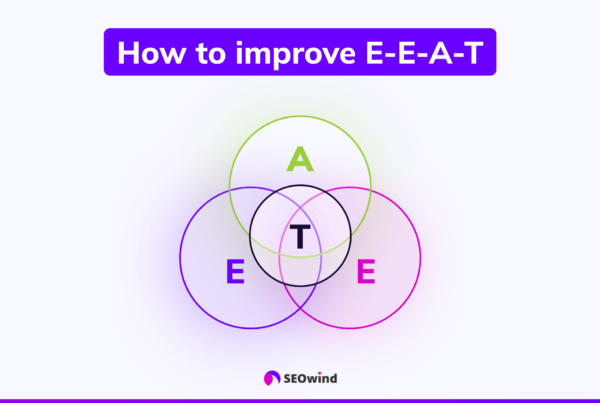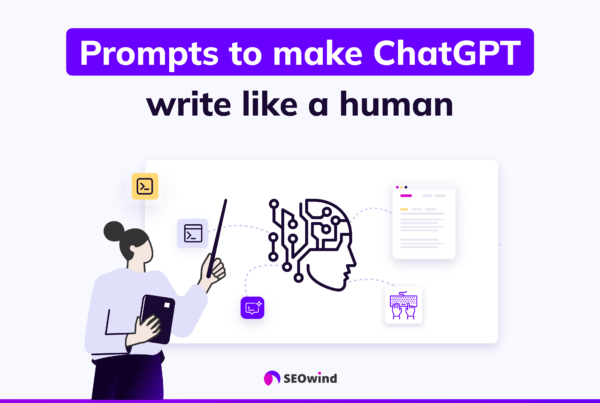Creating high-quality, engaging blog posts on a regular basis can be both time-consuming and challenging. What if there was an easier way to generate content while maintaining quality and efficiency? Welcome, AI Blog Post Generator: a game-changing tool that promises to transform the way you create content, making it faster, smarter, and better than ever before.
In this comprehensive guide, we dive deep into how AI-powered generators work, their advantages and disadvantages, best practices for using them effectively, and tips for selecting one that meets your unique blogging needs.
What is an AI Blog Post Generator?
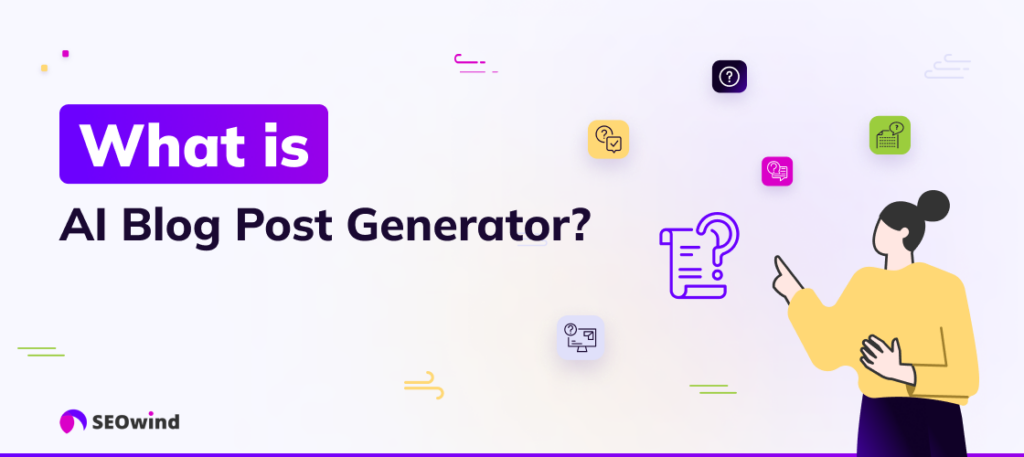
An AI Blog Content Generator is an advanced software application designed to streamline the blog writing process by leveraging artificial intelligence (AI) algorithms. These tools can produce coherent text based on inputs like keywords or specific topics provided by users.
By harnessing the power of natural language processing (NLP), machine learning techniques, and computational linguistic principles, AI Blog Post Generators analyze vast amounts of data and use those insights to formulate a natural human-like text. As a result, they mimic the writing style of an experienced blogger or content writer when generating blog posts on various subjects.
While no technology can completely replace human creativity or critical thinking skills just yet, these sophisticated applications play an increasingly important role in aiding content creators with efficiently managing their workload without compromising on quality. This cutting-edge solution allows you to stay ahead in the competitive world of content marketing while meeting (and even exceeding) your audience’s expectations.
Benefits of Using an AI Blog Post Generator
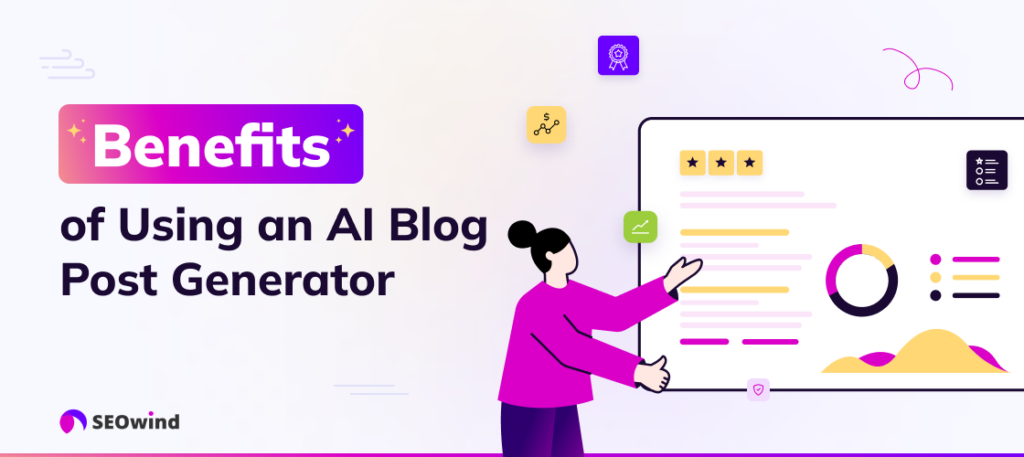
These AI writing tools offer numerous benefits to bloggers and content writers alike, some of which include:
- Time-Saving: AI-generated blog posts significantly reduce the time spent on researching, planning, and writing articles from scratch. This allows you to focus on other important tasks such as SEO optimization or marketing strategies for your blog.
- Consistency in Content Quality: Ai blog post generators ensure consistency by adhering to specific guidelines, tone, format, and structure preferred by the user. As a result, you can produce high-quality content regularly without worrying about writer’s block or varying output standards.
- Improved Writing Speed: These AI content generators use various algorithms and data resources to construct insightful blogs almost instantly. They vastly outpace manual writing speeds while still maintaining excellent quality levels.
- Efficient Brainstorming: Sometimes forming an idea takes longer than expected; however, ai article generators provide ready-made topic suggestions and outlines to inspire creativity for content creation.
- Personalized Content: Ai-generated blog posts offer personalized recommendations tailored according to reader interests – all based on collected data points such as keywords and search queries.
- Error Reduction: Most AI blog content generator tools have built-in proofreading capabilities that identify grammatical errors and misspellings before publication – ensuring polished content for every post.
- Content Optimization: Ai writes blogs with reference to natural language processing (NLP) techniques so they appear more organic when compared with traditional keyword-stuffed pieces of writing which could be penalized by search engines like Google.
- Cost-Effectiveness: Hiring full-time writers can be expensive; however, using an AI blog post generator provides a budget-friendly solution to generate articles without compromising quality or quantity.
- Expansion of Content Scope: AI content generator tools can easily diversify your blog topics while maintaining a consistent writing style, which benefits both your readers and your online authority in various niches.
By utilizing the right AI writing tools in the right way, you ensure consistent high-quality content for your site – all with reduced time investment in research and drafting efforts. As a result, bloggers stand to reap significant rewards by integrating AI generators into their content production strategies.
How does an AI Blog Post Generator work?
AI blog post generators are sophisticated tools developed using advanced artificial intelligence and machine learning algorithms. Their primary purpose is to assist content creators in creating well-written blog posts at a faster pace while maintaining high-quality standards.
Understanding Natural Language Processing and Machine Learning
The foundation of any AI blog post generator lies within its capability to process human language effectively. This is achieved through a combination of Natural Language Processing (NLP) techniques and Machine Learning (ML) algorithms. These two technologies allow the AI content generator to:
- Comprehend written text by breaking it down into meaningful units.
- Analyze grammatical structures, extract essential information, and identify relationships between different textual elements.
- Generate coherent sentences that match the intended tone and style based on context.
This intricate process helps the tool understand user intent, recognize patterns in data, and generate relevant content accordingly.
Training AI Models for content generation
AI blog post generators function using pre-trained or custom-built models that have been exposed to vast amounts of textual data from various sources, such as articles, blogs, whitepapers, etc. During the training phase:
- The ML algorithm processes this data corpus to learn linguistic structures and semantic relationships between words or phrases.
- It continuously gets refined as more data is introduced into the system for better prediction capabilities.
Once trained successfully, these models can create high-quality content with minimal human intervention.
Utilizing predefined templates and customization options
Many AI blog post generators come with predefined templates tailored for specific niches or industries, further simplifying content creation tasks for users who may not be knowledgeable in certain fields. Additionally, most platforms provide customization options such as:
- Specifying keywords
- Target reader persona
- Content length
- Article format or structure, including a detailed outline
These features allow for fine-tuning the output to suit individual needs, ensuring the generated content aligns with a brand’s identity and vision.
Generating unique content from user inputs and suggestions
Upon receiving user inputs and suggestions, AI blog post generators instantly analyze this information to identify keywords and context. They then draw data from their vast knowledge base combined with suitable writing styles for producing unique, well-structured content. Thanks to NLP techniques and iterative refining processes, the AI tool can effectively transform rudimentary ideas into engaging blog posts that resonate with readers.
Features of AI Blog Content Generators
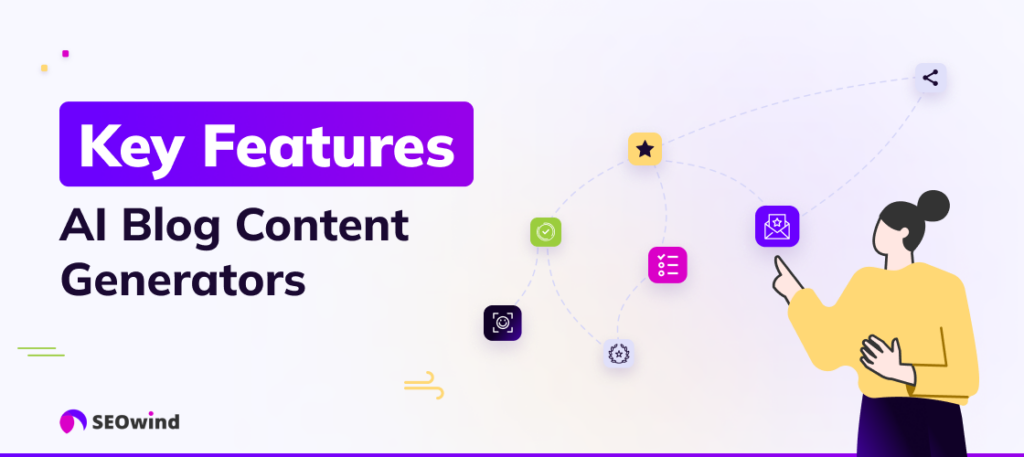
AI blog post generators are designed to provide users with various features that streamline and enhance the content writing and publishing process. Understanding the capabilities of these tools is essential for selecting the right AI-generated blog post solution. This section will explore some of the critical features and functionalities offered by common AI blog content generator tools.
Content Generation Based on Keywords or Topics
One of the most impressive functions of an AI blog post generator like SEOwind is its ability to create engaging pieces based on chosen keywords or topics. You simply input your preferred topic or keyword. Within seconds, you’re presented with a thoughtful article crafted by advanced algorithms. This frees up precious time for you to focus more on strategic tasks rather than getting caught up in the tedious work of churning out content regularly.
Different Writing Styles and Tones
Another intriguing facet of AI content generators lies in their adaptability to writing styles and tones. Understanding your audience is crucial for creating relevant and resonating content. Thus, these smart tools offer options to adjust tone – from formal academic prose suitable for technical articles to conversational vernacular for casual blogs.
Furthermore, some AI generators serve as excellent AI article writers capable of emulating various literary techniques such as storytelling, persuasion, and descriptive, among others fluently.
SEO Optimization Suggestions
Any seasoned blogger can tell you that great content alone won’t garner success; it needs to be discoverable by users online – that’s where Search Engine Optimization (SEO) comes in handy.
The good news here is that the role of an SEO specialist isn’t exclusive to humans anymore! Advanced AI blog post generators come packed with SEO optimization suggestions based on current trends and user data analysis. They ensure each produced copy is ‘Google-ready’ by incorporating integral components such as title tags, meta descriptions, or even optimized headings into their outputs.
Grammar and Spelling Checks
When it comes to written language accuracy—a fundamental feature in any writing tool—an AI blog post generator doesn’t disappoint. Equipped with grammar and spelling checks, these tools ensure that each text they produce meets high standards. They go beyond a basic grammar checker as they strive to maintain context within the content while making necessary corrections.
Content Customization Options
There’s an inherent beauty in uniqueness – this holds true even for AI-generated blogs. AI generators now offer flexible content customization options to prevent your article from sounding robotic or monotonous. You can tweak keywords, specify targeted locations, and adjust tones and styles until you’re fully satisfied with what the copy represents about your brand, product, or service.
Using artificial intelligence in creating dynamic and personable content is beginning to redefine the landscape of blog post generation. An AI blog post generator such as SEOwind embodies this shift by offering comprehensive features designed to aid its users not just to write faster but also to write smarter and, indeed, better!
Pros and Cons of Using an AI Blog Post Generator

As with any tool, AI blog post generators come with their own set of advantages and disadvantages. In this section, we will discuss the pros and cons of using such generators to help you decide whether or not they’re right for your content creation needs.
Pros of AI Blog Content Generator
- Time-saving: One of the most significant benefits of using AI blog post generators is saving you time. By quickly generating ideas or even full-length articles on various topics, these tools allow you to focus on other aspects of your business, like marketing or product development.
- Consistency: AI-generated blog posts maintain a consistent tone and style throughout the content, ensuring your brand message remains cohesive across all published materials.
- Data-driven insights: Some AI blog post generator tools offer data-driven insights by analyzing keywords, competitors’ content, and current trends to provide suggestions on what topics to write about or key points to address in your articles.
- Affordability: Many AI article writer tools require a subscription fee; however, compared to hiring a team of writers or freelancers, these tools can prove more cost-effective in the long run.
- Enhanced productivity: With automated processes taking care of content generation, you may find yourself accomplishing more tasks within shorter periods as you won’t have to worry about writer’s block or constant editing.
Cons of AI Blog Content Generator
- Lack of proper research – most AI tools don’t take into account any research on SERP, data, or specific questions people have. This means that the content is generic and not good enough for SEO.
- Lack of personalized touch: While AI-generated content might maintain consistency across your brand’s voice and tone, it may still lack the personal flavor that comes from a human writer’s unique perspective.
- Lack of originality: Due to its nature as an automated process based on predetermined algorithms, some AI-generated content might lack originality and human touch – this limits the creative aspect in some cases.
- Limited contextual understanding: While advancements are being made in natural language processing (NLP) technology every day, it’s important to remember that no algorithm can completely grasp subtleties found within human conversation and contexts just yet – this may sometimes result in awkward phrasing or incorrect information.
- Editing Requirement: AI-generated blog posts may still require a human touch for proofreading and making necessary adjustments to ensure coherence, readability, and accuracy.
- Ethical considerations: Utilizing AI technology for content creation has raised concerns about originality, plagiarism, and unethical practices within the industry – it’s essential to thoroughly vet the tools you use and be transparent with your audience about how content is generated.
Popular AI Blog Post Generators
Here are some popular AI blog post generators currently available in the market:
SEOwind
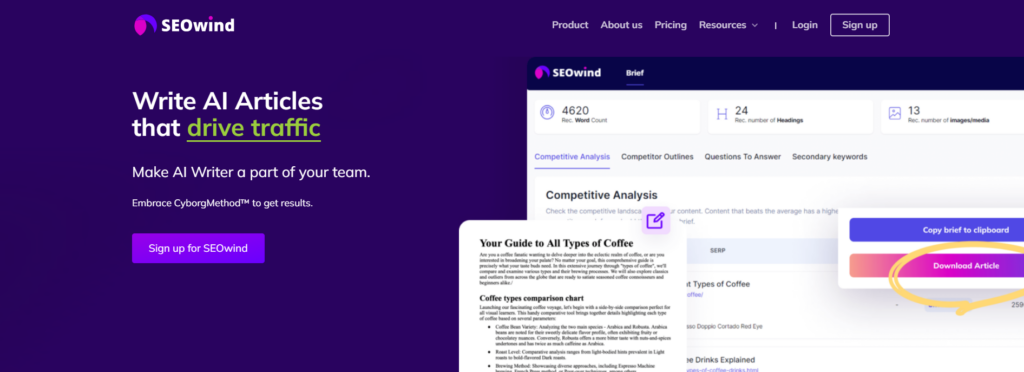
SEOwind is a leading AI blog post generator designed for businesses looking to optimize their content creation process efficiently. It allows users to generate insightful content based on extensive SEO and keyword research.
Some alluring features include:
- In-depth Content and Keyword Research
- Comprehensive Outlining Tools
- Articles created in multiple languages like English, Spanish, French, e.t.c
So before you write a comprehensive article with one click, SEOwind does the research for you. You can use its AI to generate title tags, meta descriptions, and automated outlines based on data.
Currently, the AI article-writing feature is available only for beta testers. If you would like to try it out, schedule a demo.
Jasper (formerly known as Jarvis)
Jasper is an AI blog post generator with a simple, user-friendly interface for easy navigation. It comes equipped with numerous pre-built templates catering to various content types. Still, it doesn’t conduct any in-depth SERPs research to cover the topic.
OpenAI’s ChatGPT
OpenAI ChatGPT is an interactive AI content generator tool revolutionizing the content industry using machine learning algorithms trained on millions of online conversations.
Key features of ChatGPT consist of the following:
- Generating Human-like Conversations
- Providing Dynamic responses according to user instructions
- Multilingual capabilities
ChatGPT is suitable for bloggers, chatbot developers, and customer service agents interacting extensively with customers.
Rytr
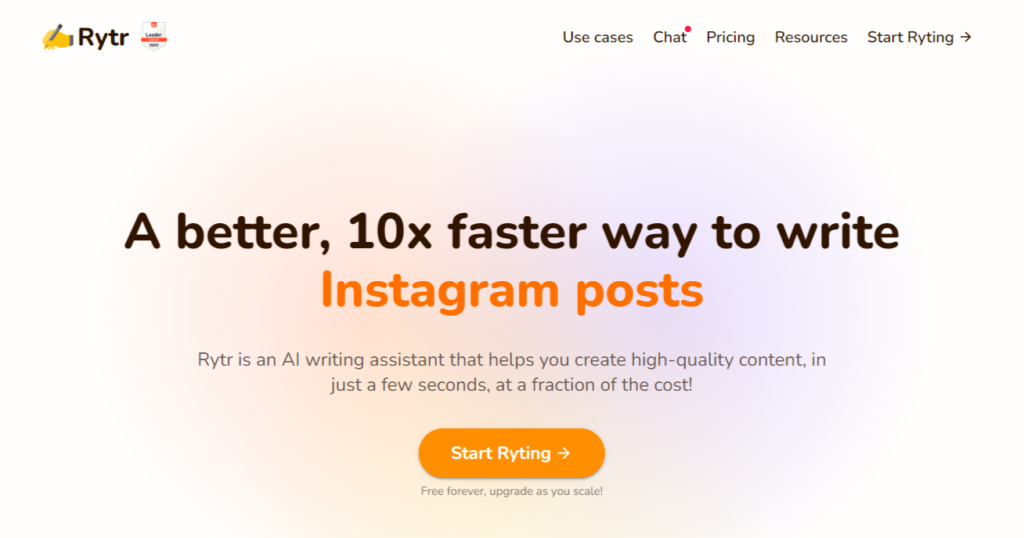
Regarding blog post writing, Rytr offers blog idea & outline along with blog section writing. Still, if you’re looking to write long-form content with one click it will not be the best solution.
Central features include :
- AI-generated blog posts
- Email Drafting Assistance
- Product descriptions synthesis
Rytr serves small businesses, individual entrepreneurs & marketers who want to churn out more engaging write-ups without wasting hours with writer’s block or subpar outsourced articles.
Writesonic
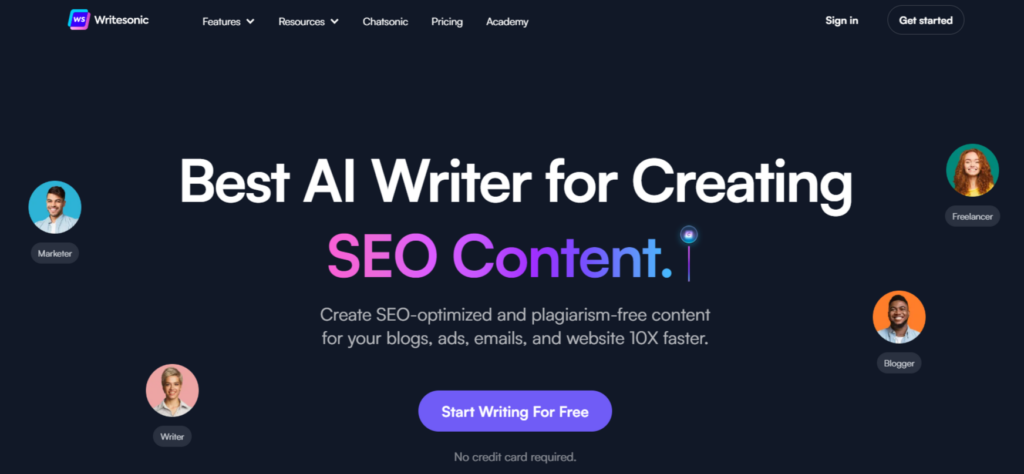
Writesonic enables you to write longer blog posts. Still, it doesn’t do any proper SERP or SEO research to base AI content.
When selecting an AI blog post generator for your content marketing needs, consider factors such as ease of use, price, and overall functionality. Compare the offerings these popular AI writing tools provide before making a well-informed decision about the platform that best meets your unique requirements.
Would you like to get to know more tools? AI Content Writing Tools – The Best of 2023
Tips for Writing a High-Quality Blog Post with an AI Generator
Using an AI blog post generator can be incredibly helpful in crafting high-quality, engaging content. However, it’s essential to follow some best practices to ensure the outcome meets your expectations and appeals to your audience. Here are a few tips to help you create exceptional blog posts using AI generators:
Before you start writing content with AI Generator

1. Understand your audience
Before starting, have a clear understanding of your target audience. Knowing your readers’ needs, preferences, and pain points will help you use the various keywords and prompts that resonate with them.
2. Set clear goals
For optimal results with ai-generated blog posts, establish clear goals for each piece of content. Specify what purpose the blog post should serve – whether it is to educate readers on a particular subject or boost conversion rates through persuasive writing.
3. Develop a compelling topic
AI blog generators work best when given thought-provoking topics as input. Craft compelling subjects that address trending issues or pressing audience needs in order to generate high-quality articles.
4. Utilize relevant keywords
Make sure you utilize 3-5 relevant keywords per section when writing the article, as suggested by the keyword clusters provided above. This practice will improve search engine optimization (SEO) and make it more likely for potential readers to find your content online.
5. Provide detailed instructions
Offering concise directions when using an ai write blog tool enhances accuracy and relevance in generated content while reducing editing efforts afterward. Specify tone, article structure, keywords to be included, and main points you’d like covered within the generated text.
6. Start with engaging headings and subheadings
AI blog post generators usually require some input from users, such as potential headlines or subheadings. Make sure these are engaging and captivating enough to draw people in and encourage them to keep reading.
7. Test different AI Generators
Explore different AI generator tools. Don’t judge them by their website. Test them on the same keyword and see what results they deliver.
After using AI Generator

8. Refine the AI article
AI-generated content may not always be perfect on its first attempt; hence, it’s essential to review and refine the output accordingly. Ensure there’s coherence between ideas within paragraphs and across sections while maintaining grammatical accuracy.
9. Focus on adding value for readers
Use the generated content as a foundation upon which you can build further information-rich articles tailored specifically for your readership needs – providing new insights or addressing their concerns.
10. Incorporate supporting research
Include references from trustworthy scientific studies or industry publications wherever possible to bolster credibility in your claims or statements.
11. Optimize content for SEO
Once you’ve generated and refined your article using AI, ensure it meets current best practices in SEO. This could involve optimizing metadata such as meta titles, meta descriptions, headings, subheadings, or even appropriate internal linking within articles.
12. Fact-check content
AI technology has its limitations; hence it’s essential to review and verify critical data points in generated pieces before publishing them – this ensures credibility and prevents misinformation among readers.
13. Verify consistency of tone and voice
After receiving your generated material from an AI copywriting tool like a blog writer ai service, compare it against your brand guidelines and ensure that the content reflects the desired tone of voice. This consistency is crucial in fostering a sense of familiarity among readers.
14. Edit and proofread
Although AI blog post generators substantially reduce editing workload, they may not produce entirely error-free content. Carefully proofread each article to eliminate grammatical mistakes or awkward phrasings – investing time at this stage pays dividends in reader satisfaction.
Make sure to:
- Correct typos or spelling errors
- Check for factual inaccuracies
- Refine the tone and style to fit your brand image
Optimize AI blog post content

15. Include visual elements
The AI-generated text doesn’t include visual elements such as images or videos by default. To optimize your content further:
- Add relevant images or charts to support key points in the article
- Use infographics to present complex data or concepts visually
- Embed videos related to the topic for increased user engagement
Visual aids not only make the content more interactive but also improve its readability.
16. Call-to-Action (CTA)
Lastly, optimizing your blog post’s effectiveness by including a clear call-to-action (CTA) encourages visitors to perform an action such as signing up for newsletters or exploring more of your website. Some tips for creating impactful CTAs:
- Make your CTA specific and appealing
- Use persuasive language with strong action verbs
- Position your CTA at strategic locations within the content
How to Use an AI Blog Post Generator (like SEOwind)
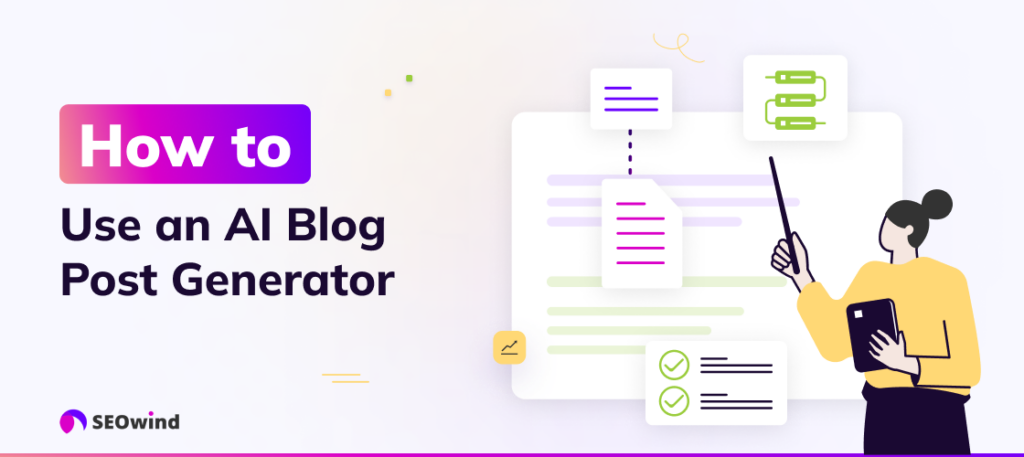
The journey towards creating more engaging and optimized blog posts using an AI blog post generator such as SEOwind is not as complex as it might seem. To assist you in navigating this pathway, let’s take a step-by-step look at the process.
Enter the Primary Keyword of Your Blog Post
Commencing the content creation process with any AI blog post generator starts by giving the tool a sense of direction regarding what your blog post should tackle. Here, you need to input the main keyword it targets.
This action sets the groundwork for defining the context within which the AI-generated content will be structured. Remember that being specific and targeted with your topics and keywords can yield more focused results from your use of AI content generators.
Customize Tone of Voice and Company Information
The next level involves customizing settings around voice tone and company information. This allows the AI article writer to incorporate unique personality traits into the written output, aligning its delivery style with that of your brand or business communication guidelines.
Your company’s identity, goals, and audience type — all these factors weigh on how successfully an AI generates content that reflects your brand accurately through text output.
Craft a Comprehensive Outline
Insights from experience reveal that having a comprehensive outline before creating detailed content improves organizational flow. Therefore, feeding the AI tool with an outline ensures proper sequencing while crafting expansive narratives through each paragraph.
The best approach is not to reinvent the wheel. Analyze the content already performed in Google and see how they nailed the search intent. This is how SEOwind does it. It writes your outline based on content research.
Select Secondary Keywords
Secondary keywords provide additional semantic layers of meaning related to your primary keyword(s). Choosing the right keywords will help AI write content that matches user queries and interests. And all this with the language they use and can relate to.
Generate Title and Meta Description
Titles and meta descriptions are paramount for the SEO optimization of blog posts. A fascinating title instantly grabs readers’ attention while directly conveying your content’s purpose. The accompanying Meta description serves as a brief summary that further entices potential readers when they encounter your post in search results.
Generate The Final Blog Post
Brace yourself; this is where magic happens: transforming all prior inputted parameters into final, polished text — Your tailor-made AI article writer is set to wow you with its rendition of human-like articulation, delivering high-quality ai-generated blog content ready for publication.
Post-edit Using the AI Blog Post Generator
Despite the remarkable proficiency of platforms like SEOwind at crafting realistic texts, they still need human intervention in some instances— they can’t rival our vast prowess in spotting context-sensitive inaccuracies or maintaining nuanced continuity across articles.
So, as parting advice, review each result and refine areas you deem unfit before publishing. It’s your choice to make whether the content is truly audience-ready.
Common Mistakes to Avoid When Using an AI Blog Content Generator
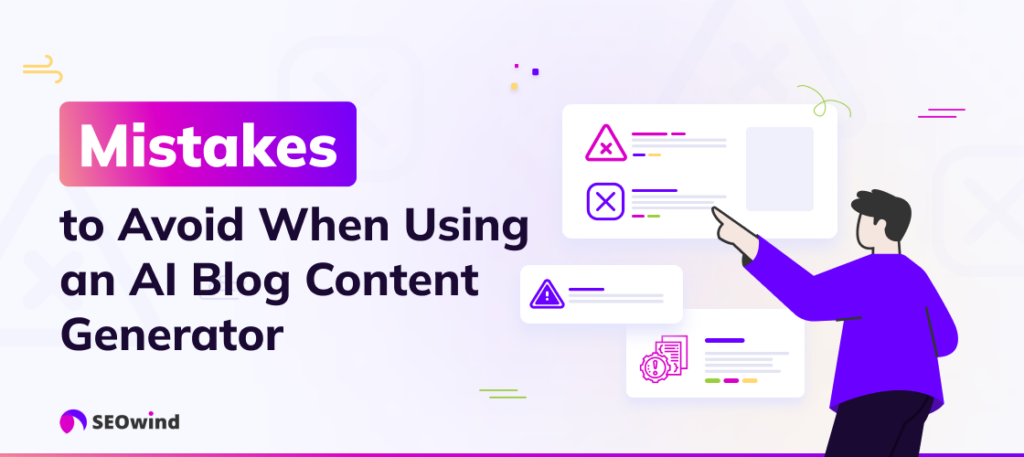
Still, it’s not mistake-free. Let’s delve into the frequently encountered mistakes and how you can sidestep them when utilizing an AI blog post generator.
Relying solely on AI-Generated Content
One major misstep among users is leaning too heavily on ai-generated blog posts without adequate human intervention. Although these tools offer efficiency and ease, they should not replace a writer completely.
Remember that the purpose of an ai content generator is to assist you in creating engaging and well-structured articles, rather than replacing human understanding and creativity. Always take the time to review, edit and polish the generated content to maintain originality and ensure that it aligns with your brand voice or writing style.
Not understanding your target audience
Another blunder in using an AI blog post generator involves neglecting to consider your target audience when generating content. Such a lack of customization may render even well-written content ineffective in reaching your intended readership.
To avoid this issue:
- Clearly define your target audience
- Familiarize yourself with their preferences and requirements
- Tailor the AI-generator inputs based on those characteristics
By doing so, you’ll be able to create personalized ai-generated blog posts that resonate better with your specific viewership, leading to increased engagement rates.
Ignoring keyword research and SEO best practices
Some users erroneously believe that using an ai article writer exempts them from worrying about keyword research or following SEO best practices. Unfortunately, overlooking these aspects can seriously hinder online visibility.
To optimize your blogs for search engines:
- Conduct proper keyword research before writing.
- Use relevant keywords contextually throughout the text.
- Adhere to SEO best practices, such as maintaining a balanced keyword density and including internal/external links
Recommended resources on keyword research: - How to do SEO Keyword Research in 2023 – Step-by-Step Guide - How to Do Keyword Research in minutes – 11 Tips & Tools
How to choose the right AI Blog Post Generator for your needs
Selecting a suitable AI blog post generator for your individual requirements is crucial, as there are multiple options available in the market. To determine which one meets your needs best, you should evaluate them based on specific criteria, such as their features, pricing models, and user-friendly interface. Additionally, consider factors like customer support and scalability. Once these aspects are evaluated carefully, you can make an informed choice and leverage an AI-driven solution that enhances your blogging performance.
What to look for in an AI Blog Post Generator
- Features: Different AI content generator tools come with varying features. Some focus on delivering grammatically-correct articles while others may prioritize keyword optimization or content personalization. Understand which feature set aligns with your goals to make an appropriate selection.
- Research and data-based – Is AI article creation based on data and research, or just creativity? If on data, what type of data does the tool analyze and how much flexibility do you have when using it?
- Ease of use: A user-friendly interface is essential for efficiently using any tool. For smooth navigation and seamless integration within your existing workflow, identify options that provide intuitive navigation and simple configuration settings.
- Pricing: Assess your budgetary requirements before choosing an ai article writer tool. There are free versions available alongside premium packages with advanced functionalities at a cost. Evaluate if investing in a paid service will yield higher returns or if a free option would suffice according to the scope of your blogging project.
- Scalability: As your blog grows over time, it’s important to have an ai blog post generator that can easily accommodate more features or expanded services when needed without affecting productivity levels negatively.
- Customer support: Ensure that the selected ai article generator comes with reliable and efficient customer support services that cater to technical issues or other inquiries promptly.
- Language compatibility: If you need to write articles in multiple languages, look for ai-generated blog post tools that offer multilingual capabilities and localized content generation.
- Reputation: Research the reputation of your prospective ai blog post generator by examining user testimonials, expert reviews, and ratings. By selecting an ai article writer with positive feedback from real users, you increase the chances of obtaining high-quality blog content at a faster pace.
Steps to follow when writing a blog post with an AI Generator

Leveraging an AI blog post generator effectively requires understanding the steps and processes involved in producing a well-written, engaging article. This will ensure that your content resonates with your target audience and drives organic traffic. In this section, let’s discuss the steps you need to follow when writing a blog post using an AI generator.
Understand your topic and define your purpose
Before diving into using the AI writing tool, it is critical to have a strong grasp of your topic and define your purpose for creating the content. This involves identifying:
- The central theme or subject matter
- The primary message or takeaway
- Your target audience
- If your activities are SEO oriented, then also do the keyword research.
Having clarity on these aspects will help you develop relevant prompts and guidelines for the AI tool, allowing it to provide more targeted suggestions.
Select an appropriate AI Writing Assistant
With numerous options available in the market, selecting the right AI-generated blog post tool for your needs might seem overwhelming. Familiarize yourself with various platforms’ features, benefits, costs, and interface before making a decision. Opt for one whose capabilities align with your requirements for seamless integration into your workflow.
Create detailed prompts and guidelines
One of the most significant benefits of using an ai writer is its ability to work effectively when given clear instructions. So once you have clarity about your topic and purpose, create detailed prompts accordingly:
- Define subtopics or specific questions that could be addressed
- Provide any potential titles or headings
- Include keywords related to the subject matter
Outline these directives comprehensively so that the ai generated blog posts clearly adhere to your intent.
IMPORTANT: Some AI blog post generators like SEOwind are doing comprehensive content research and are using the data to generate AI articles. This means that you will not need to bother with crafting the prompt, we will do that for you.
Monitor output quality and edit as needed
AI-generated content may not always perfectly match human writing standards; imperfections such as awkward phrasing or a slight lack of coherence can occur. Once you generate content initially using ai write blog tools, carefully review it and make any necessary edits. Editing for grammar, structure, consistency, and tone will further enhance the content’s quality.
Optimize content with appropriate keywords
To ensure your article gets maximum visibility on search engines, integrate relevant keywords within your generated content. AI writing assistant can effectively incorporate essential keywords without sounding forced or unnatural, helping reinforce your topic relevant to both readers and search algorithms.
IMPORTANT: The more SEO and data-oriented AI Blog Post Generators, the less work will be needed on your end.
Track results to improve future content creation
Creating engaging content doesn’t stop at publishing a single article. Monitor the performance of each blog post through analytical tools like Google Analytics to determine which topics gain traction among readers. After identifying audience preferences, tweaking prompt designs and instructions for future AI-generated posts becomes more straightforward.
Common misconceptions about AI blog post generators debunked
Addressing concerns about the quality of content generated by AI
One widespread misconception about AI blog post generators is that they compromise the quality of content creation. Critics argue that machines cannot produce persuasive and compelling content like humans due to their perceived inability to understand emotions or context.
Yet according to some studies, 20% of all business content would be authored by machines. So much for the quality concern! While they might not yet master artistic exhibition or subtle nuances as adeptly as a human writer could do, advancements in Natural Language Processing (NLP) capabilities allow these revolutionary tools to generate content impressively similar in style and tone to human-written pieces.
AI generators can leverage vast amounts of data from various sources on any given topic or keyword and diligently avoid plagiarism – features most humans would find challenging without substantial effort.
Discussion on whether AI can replace human writers
Another debate is whether AI blog post generators threaten human writers’ jobs.
The fact is that AI-generated content tools are not designed to replace humans but rather to aid them in content creation tasks. Similar to how the invention of the typewriter or word processors didn’t eliminate writers, the function of AI blog post generators is to enhance their productivity and creativity.
Consider these AI tools as your efficient assistant, helping you brainstorm ideas, create outlines, draft articles faster, check grammar, optimize SEO elements, etc. This way, it enables you more time and energy for strategic thought, research, or complex idea expression that still requires a high level of human intervention.
To put it succinctly: “AI doesn’t write – it assists.”
Common Questions About Using an AI Writing Tool
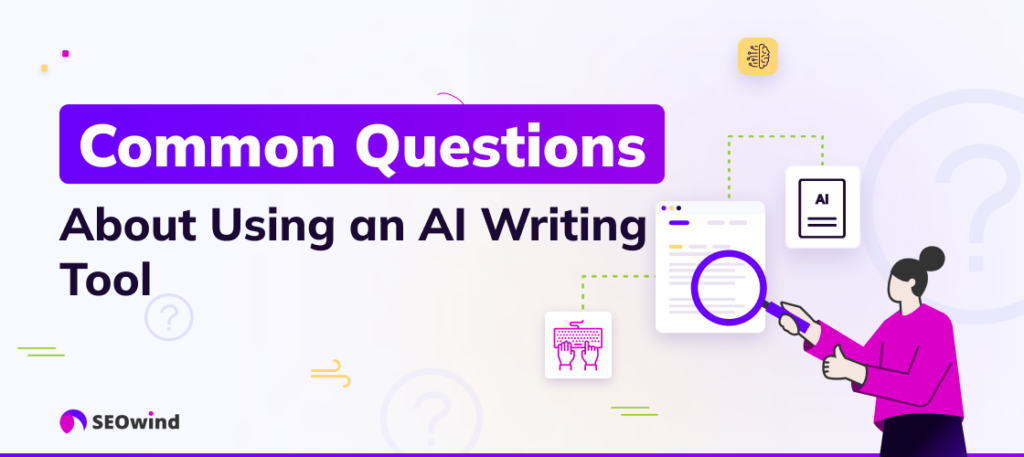
When considering the use of an AI article assistant, several questions might arise regarding its functionality, effectiveness, and practicality. In this section, I will address some of the most common queries to provide a better understanding of AI-generated blog content.
How accurate are AI Blog Post Generators?
AI blog post generators have come a long way in terms of accuracy and natural language processing. Advanced algorithms can now understand context and sentence structure much more effectively. However, AI-generated content may occasionally require edits for grammar or style. As with any writing tool, it’s essential to proofread and edit the final output to ensure high-quality content.
Will my articles sound robotic?
Modern AI blog post generators employ advanced technologies like ChatGPT (Generative Pre-trained Transformer) which enable them to generate human-like text based on input data. These tools are designed to generate articles that read naturally and engagingly. While there might be occasional instances where phrasing appears unnatural, the overall results should closely resemble those of a human writer.
Can AI Blog Writers take over human writers’ jobs?
AI article writers have undeniably transformed the landscape of professional writing by providing rapid and cost-effective solutions for content creation. Nevertheless, while they do offer immense value for specific writing tasks (such as generating metadata or quick drafts), these tools cannot replace human creativity, original ideas, or emotional engagement.
Ultimately, combining skilled human authors with efficient AI-powered tools can drive maximum productivity without sacrificing creativity or authenticity.
Do all industries benefit equally from AI content?
Not all industries will benefit equally from employing an AI blog post generator due to differences in technical complexity or niche-specific knowledge required for effective content production. For instance: subjects like healthcare or law demand precise terminology and nuanced descriptions that may be challenging for current algorithms to replicate accurately.
Nonetheless, businesses that recognize their own unique content requirements can effectively utilize AI content generators for specific purposes such as drafting ideas or developing search-engine-optimized text.
Is It ethical to use AI Blog Post Generators?
The ethical implications of using AI-generated content are subjective and dependent on the context. As long as the resulting output is transparently identified, edited, and fact-checked by human writers, there should be no fundamental moral concerns.
Collaborating with AI blog post generators allows for faster content creation while still keeping curators responsible for maintaining authenticity and veracity in their published materials. Emphasizing this partnership between human editors and advanced technologies safeguards both integrity and future innovations within the content writing industry.

